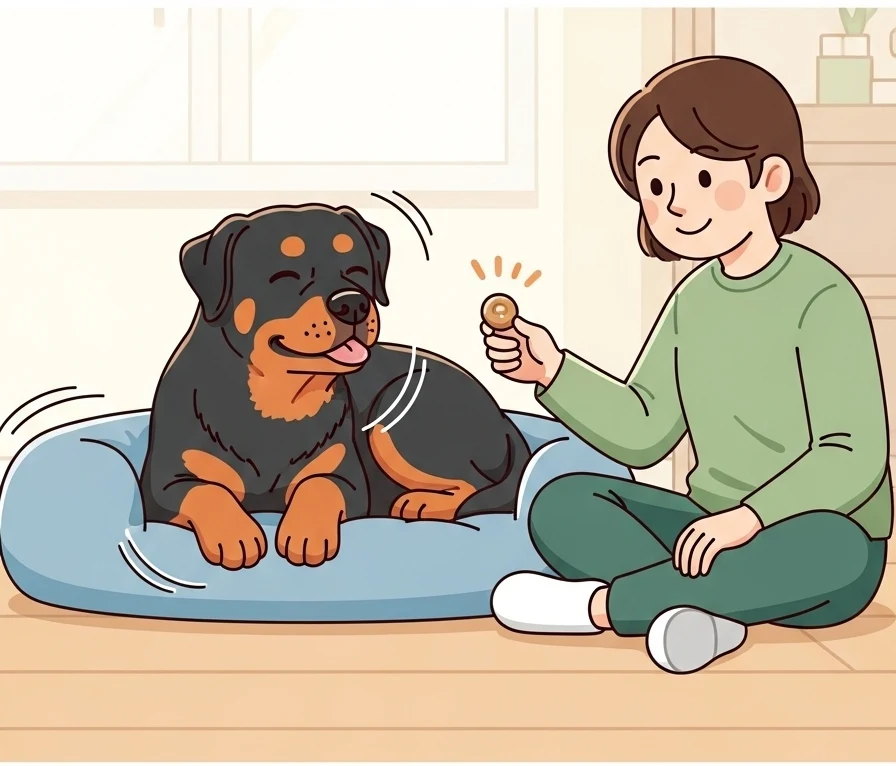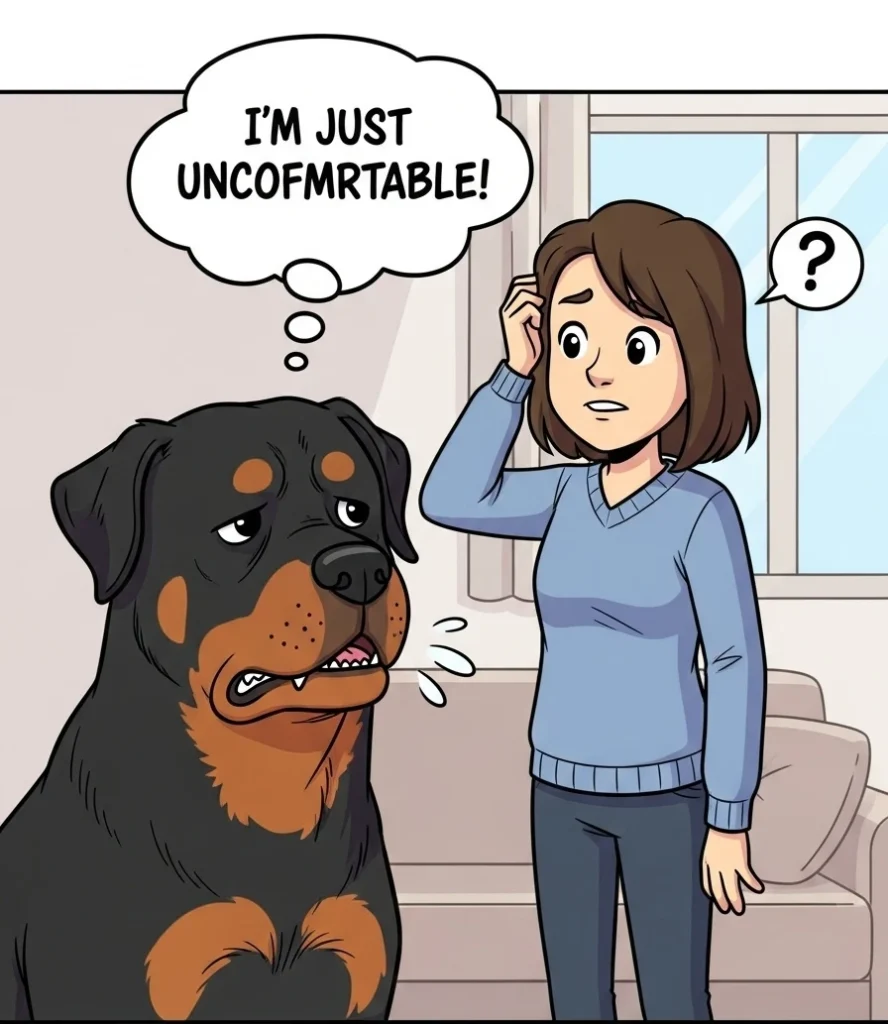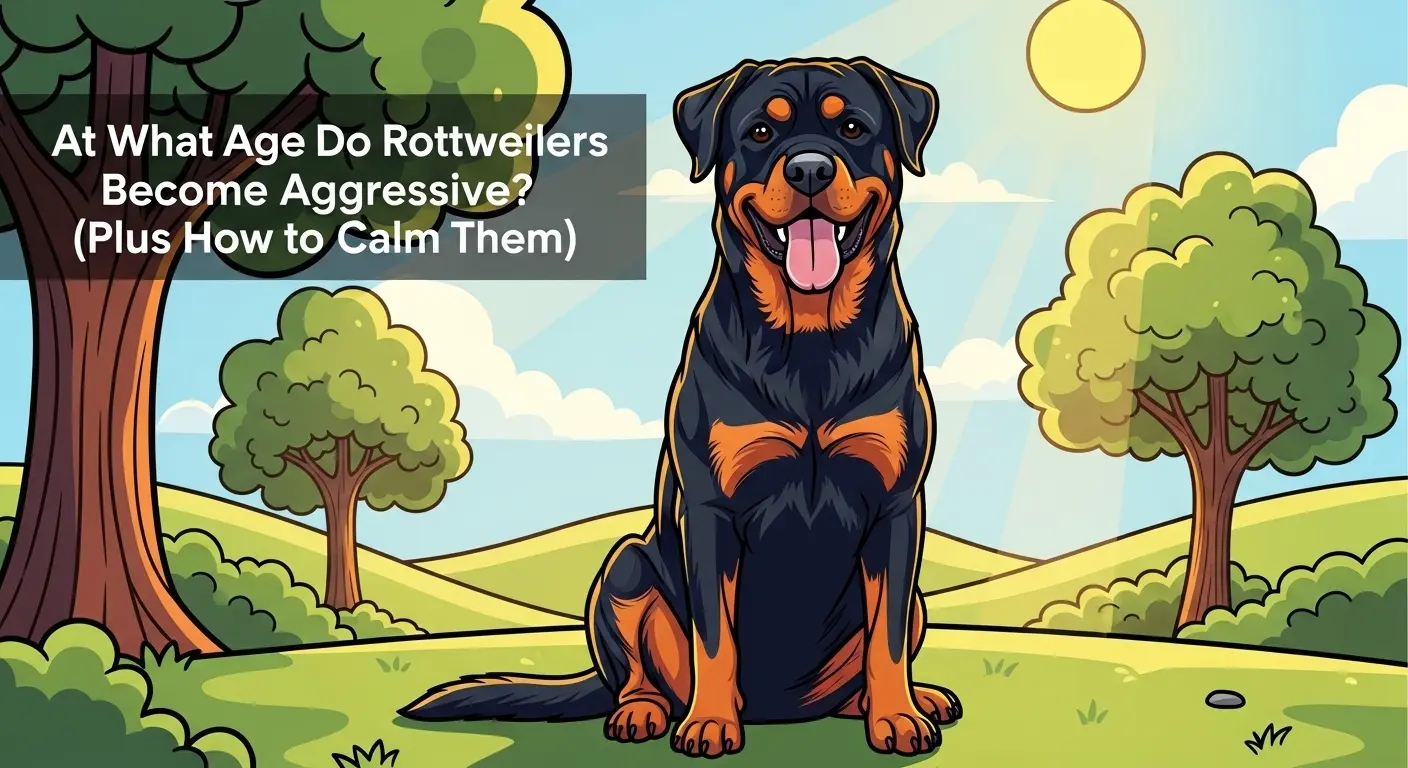So you’ve got a Rottweiler (or you’re planning to get one), and you’re wondering—at what age do they start acting up?
Maybe you’ve heard stories about “angry Rotties” or those dramatic YouTube clips where they growl like they’re auditioning for a horror movie. Relax.
Most of the time, that’s not aggression—it’s just poor understanding of dog behavior.
I’ve lived with Rottweilers long enough to know that they’re not “born aggressive.” They’re protective, loyal, and sometimes stubborn—but when raised right, they’re also giant teddy bears with muscles.
So, let’s break this down honestly: when can aggression actually start, what causes it, and—most importantly—how can you calm your Rottie before they turn your living room into a wrestling ring?
When Do Rottweilers Become Aggressive?

Here’s the truth: Rottweilers don’t just “flip a switch” one day and become aggressive. Like teenagers, they go through phases. The most common time aggression might show up is during their adolescent stage, roughly 6 months to 2 years old.
This phase can be tricky because:
- Hormones kick in. Think of it like dog puberty. They start testing boundaries, acting confident, and sometimes, they forget who’s boss (spoiler: it’s supposed to be you).
- Protective instincts grow. They begin to understand “family” and “territory,” which can make them extra alert—or reactive.
- Training gaps show. If socialization and obedience training weren’t consistent earlier, this is when you’ll start noticing issues.
But here’s the key: age doesn’t cause aggression—environment and training do. Some Rottweilers remain calm angels through adolescence, while others might growl or snap if they’re anxious, bored, or confused.
Ever met a teenager who just needed better parenting? Same idea here.
What Actually Causes Aggression in Rottweilers?
Let’s clear up the biggest myth: Rottweilers aren’t “naturally aggressive.” That’s lazy labeling.
Aggression usually comes from fear, frustration, or lack of control, not evil genes. Here are the main culprits:
1. Poor Socialization
If your Rottie hasn’t met enough people, dogs, or new environments, they might see everything unfamiliar as a threat. Socialization teaches them the world is safe—and not every stranger is out to steal their chew toy.
2. Harsh Training or Punishment
Some folks think yelling or hitting “dominates” a dog. FYI—it doesn’t. It only scares them. Rottweilers are intelligent and sensitive; harsh punishment breaks trust and makes them defensive.
3. Boredom or Lack of Exercise
These dogs were bred to work. If you keep them cooped up with zero stimulation, don’t be shocked when they start barking, growling, or chewing your couch out of sheer frustration.
4. Health Problems
Pain changes behavior. A normally sweet Rottie might growl if a joint hurts or if they’ve got a hidden infection. So, before assuming attitude problems, get a vet checkup.
5. Owner Energy
Rottweilers mirror your vibe. If you’re anxious or aggressive, they’ll pick up on that. Calm confidence from you equals calm confidence from them. Simple as that.
How to Stop Aggression Before It Starts
Okay, prevention time. The best way to deal with aggression is to stop it before it ever happens.
1. Start Socialization Early
Expose your Rottweiler to:
- Different people (including kids and men with hats—they’re weirdly suspicious of hats)
- Other dogs in controlled settings
- Noisy environments like parks, vet clinics, and sidewalks
Do this while they’re still young—preferably before six months old—and keep the experiences positive.
2. Train With Positive Reinforcement
Reward calm, confident behavior with treats or praise. Ignore minor mistakes. Consistency beats punishment any day.
Example: if your Rottie sits quietly when a stranger walks by, reward immediately. That’s how you build good habits.
3. Set Boundaries (Lovingly)
Rottweilers respect leaders who are firm but fair. Set household rules and stick to them. No couch privileges one day and then “aww okay fine” the next. Consistency keeps them grounded.
4. Provide Enough Exercise
A tired dog is a good dog. Seriously. Daily walks, playtime, obedience drills, or fetch sessions burn energy and reduce frustration.
Aim for at least 60–90 minutes of exercise a day. And no, a quick backyard pee break doesn’t count.
5. Keep Their Brain Busy
Mental workouts are just as important as physical ones. Try puzzle toys, nose games, or teaching new tricks. You’ll be amazed at how much calmer they become when their brain has something to do.
How to Calm a Rottweiler (Even a Rowdy One)

Got a Rottweiler who acts like a caffeine-fueled toddler? No worries. Calming them down is easier than you think—it just takes patience, structure, and maybe a few deep breaths (for both of you).
1. Create a Calm Environment
Give them a designated chill zone—a quiet corner with their bed or crate. It becomes their “safe space” when things get too stimulating.
2. Stick to a Routine
Dogs love predictability. Feed, walk, and train them around the same time every day. A structured life equals a relaxed mind.
3. Train the “Calm Commands”
Teach them simple commands like “sit,” “stay,” or “settle.” Use these during exciting moments, like when guests arrive. It teaches self-control and builds trust.
4. Use Play as a Reward, Not an Outlet for Chaos
Instead of wild roughhousing, use structured games—fetch, tug, or obedience drills. End playtime with calm praise to signal “we’re done now.”
5. Try Gentle Touch or Grooming
Light grooming, massage, or gentle brushing releases tension. It also helps you bond. Just avoid sensitive areas if they’re nervous.
And if none of this works? Don’t panic. Sometimes, a professional trainer or behaviorist can spot what you’re missing. (Been there, done that. Totally worth it.)
Why Does My Rottweiler Growl at Me?

Ah, the classic growl. It can be scary, sure—but it’s actually a good sign. Hear me out.
Growling is communication, not rebellion. It’s your dog’s way of saying, “Hey, I’m uncomfortable right now.” Ignoring that warning is what leads to bites.
Common Reasons Your Rottie Growls:
- Fear: Loud noises, sudden movements, or unfamiliar people.
- Resource Guarding: Protecting food, toys, or favorite spots.
- Pain: Hidden injuries or joint discomfort.
- Frustration: When they’re restrained or can’t reach something they want.
- Confusion: Mixed signals from owners (like “get off the couch” one day, “aww cuddle me” the next).
So, instead of scolding the growl, listen to it. Figure out the trigger and work on desensitizing them gradually. That’s how trust grows.
Why Do Rottweilers Bite So Much?
If your Rottweiler’s nipping habit is driving you crazy, you’re not alone. Puppies especially go through a “bitey” phase—it’s their way of exploring.
Here’s why biting happens:
- Teething: Their gums hurt, so they chew to relieve discomfort.
- Overexcitement: Some Rotties nip when they’re too hyped.
- Poor Training: They never learned bite inhibition.
- Fear or Protection: They feel threatened or think they’re guarding you.
- Pain or Illness: Always rule out medical causes.
To fix it: redirect their biting toward toys, reward gentle play, and use firm but calm cues like “no bite.” Never slap or yell—it just creates fear.
And trust me, once they grow out of puppyhood and learn control, they turn into gentle giants who wouldn’t hurt a fly (well, maybe just chase it a little).
Common Mistakes Owners Make (and How to Avoid Them)
Let’s be honest—we humans often mess up before our dogs do. Here’s what to avoid if you want a balanced, happy Rottie:
- Being inconsistent with rules. Dogs crave clarity, not chaos.
- Skipping socialization. You can’t fix fear of strangers at age three—it starts at three months.
- Using punishment-based training. It might look like it “works,” but it builds anxiety.
- Not providing enough outlets for energy. A bored Rottweiler invents problems. Usually expensive ones.
- Expecting perfection overnight. Training takes time. Patience, grasshopper. 🙂
When to Seek Professional Help
If your Rottweiler’s aggression keeps escalating, or if you’ve tried everything and still feel uneasy, call a certified dog behaviorist or trainer.
They can assess triggers, design a plan, and teach you how to handle tough moments confidently. IMO, it’s one of the smartest investments you can make for your dog—and your sanity.
FAQs
At what age is a Rottweiler fully grown?
Usually around 2 to 3 years old. Physically they’re done growing, but mentally? Think “permanent toddler with muscles.”
Do Rottweilers get aggressive with age?
Not really. Age alone doesn’t cause aggression—lack of socialization, frustration, or pain does.
What should I do if my Rottweiler becomes aggressive?
Stay calm. Remove them from the situation, avoid yelling, and consult a trainer or vet if it continues.
Final Thoughts
Rottweilers get a bad rap, but here’s the deal they’re not naturally aggressive. They’re naturally protective, intelligent, and loyal to a fault. Aggression only shows up when we fail to guide them with structure, trust, and patience.
So if you’re raising one, remember:
- Socialize early.
- Train with kindness.
- Exercise their body and brain.
- Stay calm, consistent, and confident.
Do all that, and your Rottie won’t just behave they’ll become that loyal, affectionate shadow who follows you everywhere (even to the bathroom, sorry in advance).
Because at the end of the day, aggression isn’t a Rottweiler problem it’s a communication problem. And with the right understanding, you’ll have the best protector and best friend rolled into one. ❤️🐾
